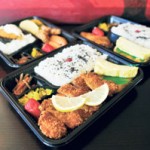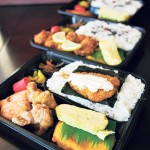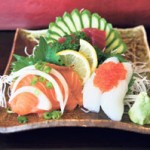In a small room near the front of Hinone Mizunone, an employee is stacking bento boxes in anticipation of the lunchtime rush.
“We make anywhere from 40 to 50 bentos each day,” says Eiki Tamaki, operation manager of the South King Street restaurant. “As soon as we open, they’re ready!”
The little boxes contain some of the most popular items on the menu at Hinone Mizunone. “We have six or seven types, and we also have mini-paks of fried chicken with omelette,” Tamaki says, adding that with a couple days’ notice, the restaurant will happily prepare bentos for group events like office parties and meetings.
“We did 350 bentos for one event,” he remembers, chuckling. “That was crazy!”
Varieties include a Mixed Bento with hoki fish and kara age chicken ($5.50), Chicken Katsu ($6.50), Pork Tonkatsu ($7), Hamburger Steak with Demi-Glaze Sauce ($6.75), Saba Netsuke (simmered mackerel, $6.75), Broiled Salmon ($7.50) and Butterfish Misoyaki ($7.25).
All bentos include pickles, sides like kinpira gobo (burdock root), croquette, and egg, and a helping of the rice that has made Hinone Mizunone a favorite destination of hungry diners looking for Japanese home-style cooking.
Made in the style of “kamadaki gohan” — a traditional method that requires large cooking pots and plenty of commitment — the rice at Hinone Mizunone is the centerpiece of many meals here. Rice is cooked in two huge metal pots in a room just off the kitchen, a small room with a big window through which guests can observe the process. It might be a bit less dramatic than watching a pizza maker flip dough or a candy maker pull taffy, but the results are nonetheless delicious.
With such elaborate preparation, one might assume that the restaurant gets its rice directly from Niigata, Japan’s famed rice-growing district. But the rice at Hinone Mizunone comes from California, Tamaki says, and favorite brands include Tamaki Classic and California Koshihikari.
“Our cooking method is supposed to bring out the sweetness in rice,” he explains. “Of course, any rice is good when you first cook it, but you can really taste the difference when our rice is cold.” He displays a black enamel bowl, much larger than single-serving size. “We serve it in one of these, almost full. The majority of people can’t finish; they take it home and warm it up.”
Owned by Japanese restaurant giant Fujio Food Systems, Hinone Mizunone opened in April 2008 as the company’s first American location. The 700-plus restaurants in the Fujio group offer about 20 different culinary styles, most focusing on Japanese home-style cuisine.
And that’s the focus at Hinone Mizunone, too. “We try to keep it simple,” says Tamaki. “Family dining is our concept; it’s simple food you’d serve at home. That’s how we want to keep it.” He mentions The Wisteria, Honolulu’s long-lived, much-loved Japanese restaurant that closed a few years ago. “Many of our regulars feel the same concept here,” he adds.
Keeping regular customers happy is important, as they represent about 80 percent of Hinone Mizunone’s business. “Especially lunch. We have customers who come three or four times a week,” Tamaki says proudly.
 Butterfish Misoyaki ($13)
Butterfish Misoyaki ($13) Katsutama ($13)
Katsutama ($13)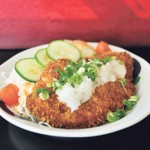 Tonkatsu (Pork Katsu) with Homemade Sauce ($10.50)
Tonkatsu (Pork Katsu) with Homemade Sauce ($10.50)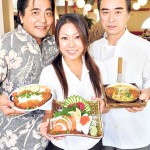 Operations manager Eiki Tamaki, server Anri Kato and Chef Teruo Aonuma with an assortment of dishes awaiting Hinone Mizunone customers.
Operations manager Eiki Tamaki, server Anri Kato and Chef Teruo Aonuma with an assortment of dishes awaiting Hinone Mizunone customers.
Regulars return for the Ahi Sashimi Teishoku ($14) and the Chicken “Ama-Kara Age” ($10.50), Hinone Mizunone’s famous crispy fried chicken with grated daikon and sweet ginger sauce. They come for the Japanese Hamburger with Demi-Glaze Sauce ($12/combo; $7.75/a la carte), a cross between a hamburger and a slice of meat-loaf. Fish lovers often order the Butterfish Misoyaki ($12/combo) and broiled salmon ($10/combo; $6.50/a la carte).
Daily specials (all are $8.50) change each month, and recently included Salmon Tempura Teishoku, Pork Curry Udon, and Ozouni, the special New Year’s mochi soup.
Four types of sake are available ($8-$20) and three types of sho-chu: barley, potato and rice (all $4.75). And there’s Sapporo on tap for $3.50 per glass, $12 per pitcher.
Located in a building that once housed a Taco Bell, the restaurant’s red tile roof has been painted black, and its white stucco exterior has been replaced with warm wood for a traditional Japanese look. Inside, the decor is bright and contemporary. One of the most charming decorative elements consists of several thin wood wheels hanging from the ceiling, from which tiny red paper figures dangle, shimmying and dancing at the slightest breeze.
“Those are like dream catchers,” says Tamaki. “They’re supposed to bring in the customers.”
Hinone Mizunone
- Where
- 1345 South King Street
- Honolulu, HI 96814
- Call
- (808) 942-4848
- Hours
- Lunch served from 11 a.m. – 5 p.m.
- Dinner served from 5 p.m. – 9 p.m.
See more articles from: Hinone Mizunone
